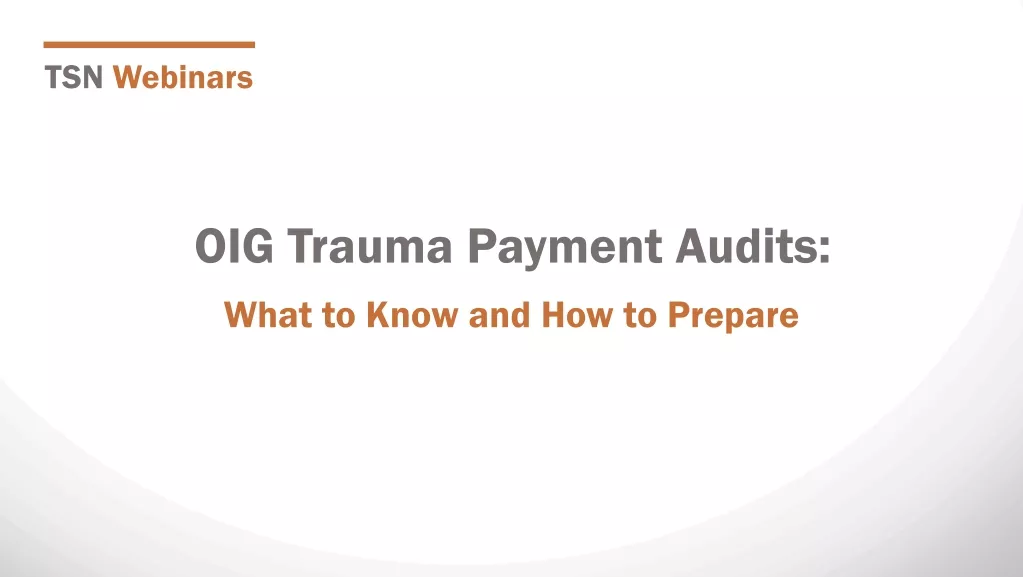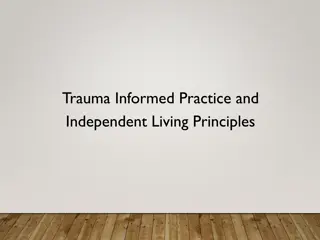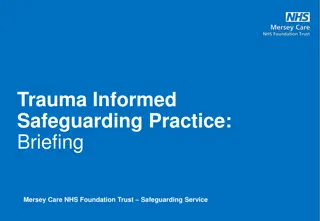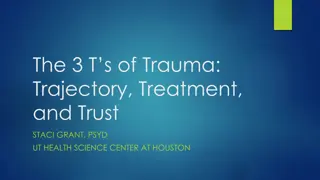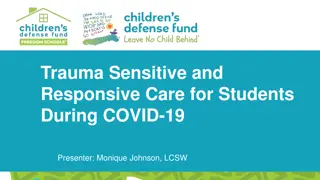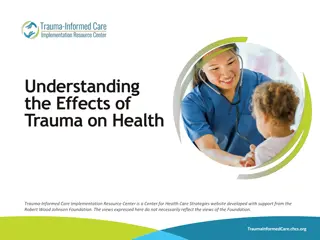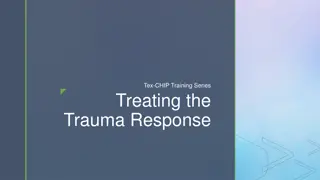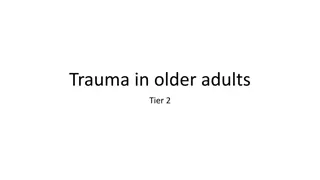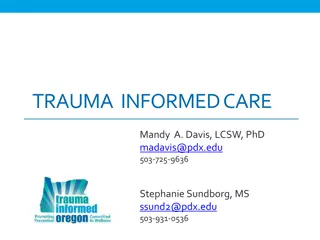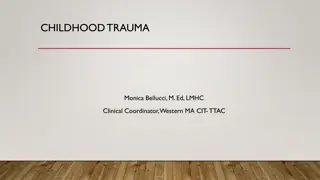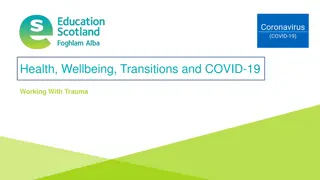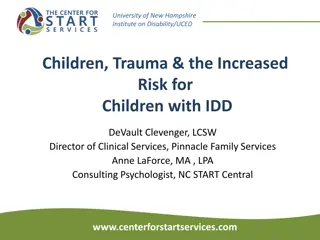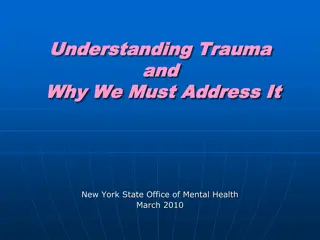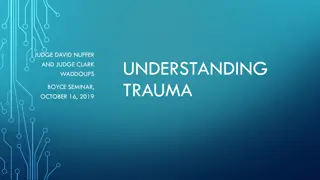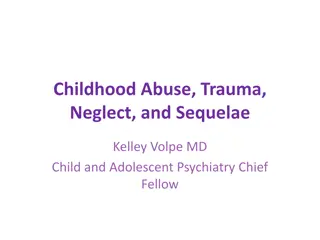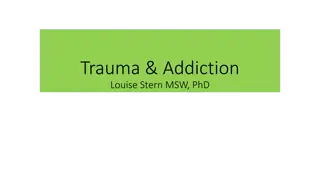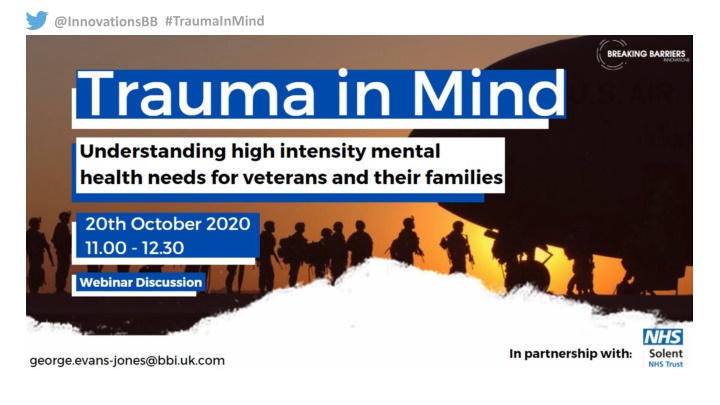
Trauma: Research Findings and Support Strategies
Explore the research findings and support strategies related to trauma experienced by veterans and their families. Dive into the demographics and lived experiences of individuals affected by trauma-related mental health issues, highlighting the importance of effective service responses and support for family members.
Download Presentation

Please find below an Image/Link to download the presentation.
The content on the website is provided AS IS for your information and personal use only. It may not be sold, licensed, or shared on other websites without obtaining consent from the author. If you encounter any issues during the download, it is possible that the publisher has removed the file from their server.
You are allowed to download the files provided on this website for personal or commercial use, subject to the condition that they are used lawfully. All files are the property of their respective owners.
The content on the website is provided AS IS for your information and personal use only. It may not be sold, licensed, or shared on other websites without obtaining consent from the author.
E N D
Presentation Transcript
Please note these slides are animated in places, so should be viewed in presentation mode throughout
@InnovationsBB #TraumaInMind Dr Jon Bashford Director of Research Breaking Barriers Innovations
What We Asked How We Did It Literature review of national and international evidence How are veterans and their families affected by trauma-related mental health problems? 1 What are the existing service provision and pathway gaps in meeting these needs and the needs of families? 2 Professional stakeholder interviews: 25 (managers & practitioners and clinicians from NHS providers; criminal justice agencies; armed forces charities; general CVS; providers and commissioners locally in Solent and nationally) What are the most effective service responses for meeting these needs? 3 How to better support family members, in particular spouses, parents and grandparents? 4 Lived experience: 101 participants (71 veterans, 25 family, 5 reservists) 5 How can services be scaled up nationally?
Demographics: lived experience sample (n=71) Forces served in Location 60.0% Wales 50.0% Wider South West North East 40.0% Midlands 30.0% Wider Hampshire 20.0% South East North West 10.0% Solent 0.0% Army Navy Airforce 0% 10% 20% 30% 40% 50% Sex Physical disability Female 23% 60.0% 50.0% 40.0% Male 30.0% Female 20.0% 10.0% Male 77% 0.0% No Not known Yes
Demographics: lived experience sample (n=71) Age Veterans - Marital status (n = 71) 40% 50% 40% 30% 30% 20% 20% 10% 10% 0% 0% 18 - 24 25 - 31 32 - 41 42 - 51 52 -61 62 - 71 71+ Married Not known Single Civil Partnership Sexual orientation Ethnicity 70% 100% White British, 95.8% 60% 80% 50% 40% 60% 30% 40% BAME, 4.2% 20% 10% 20% 0% Heterosexual Not known LGBT 0%
Demographics: family, friends & carers (n=25) Relationship Sex Male 20% 70% 60% 50% 40% Male 30% Female 20% 10% 0% Female 80% Wife Mother Father Husband Brother Carer Age Forces served in 35% 60% 30% 50% 25% 40% 20% 30% 15% 20% 10% 10% 5% 0% 0% 18 - 24 25 - 31 32 - 41 42 - 51 52 -61 62 - 71 Navy Army Airforce
What is Trauma? Impact of Trauma Treatment Co-morbidity/differential diagnosis Psychological impacts ? Conclusions & Future Model Understanding Trauma Suicide & self-harm Engaging in Treatment ? Social impacts Violence & offending Transition & trauma Sustaining in Treatment Experience of families Prevalence Children of parents with PTSD Diversity & Inclusion
Range of diagnostic frameworks result in confusion about What is Trauma? Impact of Trauma primary diagnosis & overlapping nature of symptoms Treatment Usefulness & applicability of PTSD is subject to much Co-morbidity/differential diagnosis debate, for example: Psychological impacts ? Many purported sufferers lack formal diagnosis Conclusions & Future Model Understanding Understanding Trauma Trauma Can distress be medicalised? To what extent? Suicide & self-harm Engaging in Treatment ? Social impacts Guilt, shame and complex emotional problems Violence & offending What factors support resilience during & after trauma Transition & trauma Sustaining in Treatment Experience of families Prevalence Children of parents with PTSD Some treatments may be harmful not always clear Diversity & Inclusion Medication is used commonly though not always best
UK veterans PTSD rate serving in Afghanistan & Iraq: 4% in 2004/06 but 6% in 2014/16 (4.4% in civilian population) There is a high level of trauma across the spectrum of needs in mental health service users, also a lot of inter-generational trauma, substance use, deprivation factors, domestic violence, offending. (Professional stakeholder) What is Trauma? For regulars still serving, overall prevalence is 4.8% and higher in ex-regular veterans at 7.4% Understanding Trauma PTSD rate among ex-service regulars who had not deployed: 5.0%; among those who deployed the rate was 9.4% For those whose last deployment was a combat role the rate was 17% (only 6% among those in a service support role) with these more complex issues. (Professional stakeholder) It is very difficult to estimate the numbers of people PTSD ranks 14th amongst psychiatrists in clinical practice Prevalence Prevalence People only really seek help when it s too late [ ] 8th most frequent diagnosis amongst clinical psychologists and then you only get help when things explode. (Veteran)
What is Trauma? Impact of Trauma Treatment Co-morbidity/differential diagnosis Psychological impacts ? Conclusions & Future Model Understanding Trauma Suicide & self-harm Engaging in Treatment ? Social impacts Violence & offending Transition & trauma Sustaining in Treatment Experience of families Prevalence Children of parents with PTSD Diversity & Inclusion
People with complex trauma may be diagnosed with multiple coexisting mental health problems and conditions such as substance misuse, eating disorders, self-harming and suicidality Impact of Trauma Impact of Trauma Co-morbidity/differential diagnosis diagnosis diagnosis Co-morbidity/differential Co-morbidity/differential Changes in diagnostic criteria add to challenge of understanding differential diagnosis (e.g. Complex PTSD is in part, a reformulation of EPCACE) Psychological impacts ? Experience of families Psychological impacts Suicide & self-harm Suicide & self-harm Common sense of enduring personality change, but not clearly associated with service: sometimes about early childhood trauma or transition from the forces Social impacts Social impacts Violence & offending Violence & offending Transition & trauma Transition & trauma Some symptoms of Complex PTSD very similar to BPD not all professionals are aware of Complex PTSD Experience of families Children of parents with PTSD PTSD Children of parents with Diversity & Inclusion Diversity & Inclusion
Impact of Trauma Impact of Trauma High levels of comorbidity, where symptoms were shared with or resembled other mental health problems, including: Co-morbidity/differential diagnosis diagnosis Co-morbidity/differential Agoraphobia which also involved avoidance and hypervigilance Psychological impacts ? Experience of families Psychosis involving hallucinations that appeared like flashbacks Psychological impacts Suicide & self-harm Suicide & self-harm Depression that included withdrawal and a negative self-concept Social impacts Social impacts Implications are that risks of misattributing symptoms to PTSD could affect treatment and likely benefit of treatment. Other co-morbidity factors include: Violence & offending Violence & offending Transition & trauma Transition & trauma Mild Traumatic Brain Injury (MTBI) Experience of families Chronic physical conditions and disability Children of parents with PTSD PTSD Children of parents with Alcohol and drug use Diversity & Inclusion Diversity & Inclusion
Impact of Trauma Impact of Trauma Common experiences of trauma amongst participants included: Co-morbidity/differential diagnosis diagnosis Co-morbidity/differential Feelings of hyper anxiety and fear, especially in crowds (66.2%) Poor sleep patterns with frequent nightmares (59%) Psychological impacts ? Experience of families Psychological impacts Rapidly changing moods including guilt, remorse & depression (56%) Suicide & self-harm Suicide & self-harm Feelings of powerlessness and an inability to cope (58%) Social impacts Social impacts Feelings of overwhelming anger and rage (39.5%) Violence & offending Violence & offending Self-harm and attempted suicide (35%) Transition & trauma Transition & trauma Experience of families Children of parents with PTSD PTSD Children of parents with Diversity & Inclusion Diversity & Inclusion
Self-harm research among UK veterans is rare, but some studies suggest it s increasing. E.g. from 1.8% among serving personnel and 3.8% among veterans in 2004/06 to 1.9% and 4.5% in 2007/09 and to 4.2% and 6.6% in 2014/16. The study concludes: Impact of Trauma Impact of Trauma Co-morbidity/differential diagnosis diagnosis Co-morbidity/differential Veterans were consistently significantly more likely to report lifetime self-harm than serving personnel Psychological impacts ? Experience of families Psychological impacts Suicide & self-harm Suicide & self-harm Significant determinants of lifetime self-harm included current mental disorder symptoms, stigmatization, poor social support, suicidal ideation, and seeking help from formal medical sources Suicide prevention should focus on ameliorating mental disorder by encouraging engagement with treatment, reducing negative views of mental illness, and fostering social support Social impacts Social impacts Violence & offending Violence & offending Transition & trauma Transition & trauma Experience of families Children of parents with PTSD PTSD Children of parents with Diversity & Inclusion Diversity & Inclusion
Some of the known factors that predict suicide are prominent amongst the lived experience of the veterans who participated. For example: Impact of Trauma Impact of Trauma Co-morbidity/differential diagnosis diagnosis Co-morbidity/differential Habitual poor coping Psychological impacts ? Experience of families Serious financial problems Psychological impacts Suicide & self-harm Suicide & self-harm Severe anxiety and panic attacks Social impacts Social impacts Depressed mood and/or a diagnosis of major affective disorder Violence & offending Violence & offending Recent loss of an interpersonal relationship Transition & trauma Transition & trauma Recent abuse of alcohol or illicit substances coupled with feelings of hopelessness, helplessness and worthlessness Experience of families Children of parents with PTSD PTSD Children of parents with Important to note social support provided a buffer against both lifetime self-harm and suicide attempts (Chool et al., 2017) Diversity & Inclusion Diversity & Inclusion
Impact of Trauma Impact of Trauma Alongside psychological impacts, people describe significant social and interpersonal issues: Co-morbidity/differential diagnosis diagnosis Co-morbidity/differential Relationship problems and breakdown (62%) Psychological impacts ? Experience of families Loss of employment (49%) Psychological impacts Suicide & self-harm Suicide & self-harm Financial problems (45%) Social impacts Social impacts Homelessness (22%) Violence & offending Violence & offending Offending (12.6%) Transition & trauma Transition & trauma Problematic use of alcohol (45%) and/or drugs (15%) Experience of families Experience of discrimination and prejudice (15.5%) Children of parents with PTSD PTSD Children of parents with People feel less able to engage with helping services if their social situation is unstable, but they also need psychological help to create and sustain that stability Diversity & Inclusion Diversity & Inclusion
Risk factors for violent behaviour included: having a combat role in deployed personnel, self reported aggressive behaviours, increased exposure to traumatic events, alcohol misuse and symptoms of PTSD Impact of Trauma Impact of Trauma Co-morbidity/differential diagnosis diagnosis Co-morbidity/differential Violent incidents increase following deployment but also thought to be associated with adversity prior to serving and are higher amongst those using alcohol problematically and with self-reported PTSD Psychological impacts ? Experience of families Psychological impacts Suicide & self-harm Suicide & self-harm I would just become uncontrollably angry; I would lash out at anyone in the way. (Veteran) Social impacts Social impacts He had such rage, so angry at me, the kids it just came from nowhere (Family member) Violence & offending Violence & offending Transition & trauma Transition & trauma In the adult male prison population, veterans constitute the largest occupation group, approximately 4% of the current prison population (HMPPS, 2019) Experience of families Children of parents with PTSD PTSD Children of parents with Diversity & Inclusion Diversity & Inclusion
Impact of Trauma Impact of Trauma Problems with transition can itself be a cause of trauma: Loss of employment especially when resulting in financial pressures, relationship problems, loss of stable accommodation Co-morbidity/differential diagnosis diagnosis Co-morbidity/differential Psychological impacts ? Experience of families Psychological impacts Relationship breakdown due to interpersonal problems or additional stressors created by poor adaption to civilian life Suicide & self-harm Suicide & self-harm Social impacts Social impacts Loss of esteem and social role, which can add to feelings of isolation and dissociation Violence & offending Violence & offending Transition & trauma Transition & trauma It can be the transition that actually causes problems, veterans are not recognised, their skills aren t recognised, they aren t taken seriously and treated as an individual. (Professional stakeholder) Experience of families Children of parents with PTSD PTSD Children of parents with Diversity & Inclusion Diversity & Inclusion
Impact of Trauma For veterans, trauma related mental health problems are not just experienced by the individual, but by the whole family Co-morbidity/differential Co-morbidity/differential diagnosis diagnosis For those with significant problems the strains can cause relationships and family breakdown, leaving people more vulnerable Psychological impacts Psychological impacts Suicide & self-harm Suicide & self-harm Family members often do not understand the problems a veteran may be experiencing, nor the timescales involved in recovery, which can be longer than some can tolerate Social impacts Social impacts Violence & offending Violence & offending Families are often at the frontline in care and supporting recovery, but their support needs are consistently viewed by participants as unmet by services Transition & trauma Transition & trauma Experience of families Experience of families Children of parents with Children of parents with PTSD PTSD Diversity & Inclusion Diversity & Inclusion
Parents with elevated levels of trauma may pass on psychological vulnerabilities to children, which can impact on childhood development and cause acute distress (Leen-Feldner, et al. 2013) Impact of Trauma Co-morbidity/differential Co-morbidity/differential diagnosis diagnosis Parenting behaviours can become more negative, including lack of engagement with children and displays of anger or violence, which are also associated with children experiencing problems (Fitzgerald, et al. 2017). Psychological impacts Psychological impacts Suicide & self-harm Suicide & self-harm Parental PTSD has also been associated with PTSD in children alongside other problems including substance use, depression, anxiety and suicidal ideation (O Toole, et al. 2018). Social impacts Social impacts Violence & offending Violence & offending Transition & trauma Transition & trauma Experience of families Experience of families Children of parents with Children of parents with PTSD PTSD Diversity & Inclusion Diversity & Inclusion
Impact of Trauma Impact of Trauma Trauma disproportionately affects marginalised population groups, for example: Co-morbidity/differential diagnosis diagnosis Co-morbidity/differential Low socio-economic status Psychological impacts Psychological impacts Ethnic minorities Suicide & self-harm Suicide & self-harm Younger age groups Social impacts Social impacts Gay, Lesbian and Transgender participants to the needs assessment report a high degree of occupational trauma related to their treatment under the ban on homosexuality Violence & offending Violence & offending Transition & trauma Transition & trauma They also report feeling less confident to access some sources of veterans support due to fears about discrimination and prejudice Experience of families Experience of families Children of parents with PTSD PTSD Children of parents with Diversity & Inclusion Diversity & Inclusion
What is Trauma? Impact of Trauma Treatment Co-morbidity/differential diagnosis Psychological impacts Conclusions & Future Model Understanding Trauma Suicide & self-harm Engaging in Treatment ? Social impacts Violence & offending Transition & trauma Sustaining in Treatment Experience of families Prevalence Children of parents with PTSD Diversity & Inclusion
Treatment Engaging in Treatment Sustaining in Treatment
Treatment Sustaining in Treatment Engaging in Treatment Promoting awareness and being trauma- informed No wrong door with low or invisible thresholds Increasing public awareness and reducing stigma Holding the case Raising awareness for primary care staff Promoting trust and strengthening control Enabling trauma- informed emergency & urgent care response Participation of family members in support and treatment
What is Trauma? Impact of Trauma Treatment Co-morbidity/differential diagnosis Psychological impacts Conclusions & Future Model Understanding Trauma Suicide & self-harm Engaging in Treatment ? Social impacts Violence & offending Transition & trauma Sustaining in Treatment Experience of families Prevalence Children of parents with PTSD Diversity & Inclusion
Meeting expressed needs from lived experience Encompass broad definition of trauma - across system Conclusions Recognise there is no single way problems manifest ? No wrong doors Engage with veterans and family members at earliest point Prevent most serious harms rapid response Inclusive & therapeutic environment instilling trust & confidence veteran specific, address discrimination
Local Service Model Effective case management and care coordination Conclusions Speedy & appropriate transfer between service intensities without having to signpost to separate services Risk assessment, triage & integrated care pathways NHS and AFC ? Holistic approach biopsychosocial model of care Integrated leadership underpinned by effective governance, with risk-sharing agreements and accountability for decisions care quality
Scaling Up to a National Model An integrated model across TILS, CTS, HIS and AFC Future Model Collaboration cross professions/agencies but with a consistent point of contact & co-ordination ? Prevention - Asset Based Community development (ABCD) Sustaining commitment to veterans services NHS-led collaboratives with right balance for specialist care Care closer to home - when required access to an appropriate residential model with aftercare
What is Trauma? Impact of Trauma Treatment Co-morbidity/differential diagnosis Psychological impacts Conclusions & Future Model Understanding Trauma Suicide & self-harm Engaging in Treatment ? Social impacts Violence & offending Transition & trauma Sustaining in Treatment Experience of families Prevalence Children of parents with PTSD Diversity & Inclusion

![[PDF⚡READ❤ONLINE] Zen Mind, Beginner's Mind: 50th Anniversary Edition](/thumb/20459/pdf-read-online-zen-mind-beginner-s-mind-50th-anniversary-edition.jpg)
